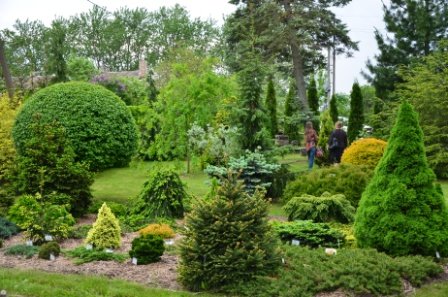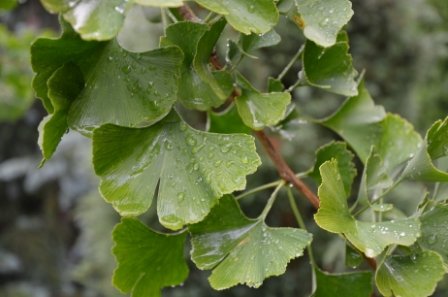The purpose of the division is to search for viable plants, suitable for cultivation in harsh conditions of northern Lithuania, conduct a research on plant introduction and acclimatisation and to gather a collection of ligneous plants for educational and scientific projects.
The division includes 279 coniferous and 680 leafy trees and shrubs. The largest families are:
- Heather family (Ericaceae) with 302 taxa. The biggest genera of the family contain rhododendrons (Rhododendron) with 185 varieties and breeds including heather (Calluna) with 38 varieties.
- Cypress family (Cupressaceae) with 147 taxa. The most common genera include: juniper (Juniperus) – 79 taxa, false cypress (Chamaecyparis) – 31 taxa, thuja (Thuja) – 34 taxa.
- Pine family (Pinaceae) with 118 taxa. The most common genera are: spruce (Picea) – 45 taxa, pine (Pinus) – 46 taxa, fir (Abies) – 14 taxa.
- Rose family (Rosaceae) with 98 taxa. The biggest genus of the family is cotoneaster (Cotoneaster) containing 18 taxa.
Other prevalent genera include: barberry (Berberis) – 35 taxa, currant (Ribes) – 21 taxa, maple (Acer) – 19 taxa, spindle-tree (Euonymus) – 18 taxa and honeysuckle (Lonicera) – 16 taxa.

The plants are grown from seeds, obtained through the seed exchange programme, from gardens located in various parts of the world. Other planting material is received from botanical gardens, arboretums and private dendrologists from Lithuania and neighbouring countries.Origin
Growing conditions
The trees of the dendrology division do not need a fertile soil, apart from plants belonging to heather family which require acidic peat substrates for optimal growth. However, most of the florae from southern regions need special care. They need to be covered from the sun during the early spring and protected from cold with fir tree branches during the cold season. Several woody plants create favourable growing conditions for other plant collections by providing shade.
Some fascinating plants grown in the division include:
Yellow poplar (Liriodendron tulipifera) originated from North America. It can grow up to 22 meters in height in Lithuania and up to 60 meters if grown in its natural habitat. The leaves have a unique shape with 2–3 deep lobes and wedge-shaped base. Yellow poplar is exceptionally beautiful in autumn when it glows with yellow and orange colours. As an ornamental tree it is valued not only for its gorgeous leaves but also for exceptional tulip-like flowers that can grow up to 6 cm in length.
Dwarf birch (Betula nana) is one of the species, belonging to a birch genus, which grows as a shrub 20–70 cm in height. Its leaves are round, 6–20 mm in length with a bluntly toothed margin. Dwarf birch is indigenous to Europe, Asia, arctic and subarctic areas of North America and mountains of middle latitude. In Lithuania dwarf birch is known as a rare and endangered relic of flora from the subarctic climate of glacial period. It is included in the Lithuanian Red Data Book.
Dawn red-wood (Metasequoia glyptostroboides) is local to Hubei province in China; however it is widely grown in various parks and dendrological collections around the world. Dawn red-wood’s spikes are soft, 1–3 cm long, arranged in two rows around a twig. It can grow up to 30–40 m in its natural habitat. This tree species is 50 million years old and was thought to be extinct until 1943.
Maidenhair-tree (Ginkgo biloba) is a dioecious tree (it can develop as a male or female) that grows up to 35 m and can survive for 1000 to 4000 years. It has fan-shaped, emerald leaves with a long stem that become bright yellow during the autumn. Maidenhair-tree had already existed 250 million years ago (during the Permian Period), when all of birds and animals became extinct due to a cataclysm. Maidenhair-tree was called a “living fossil” by Charles Darwin, because it has remained almost unchanged over the years. Ginkgo trees are planted around the temples of China and Japan to prevent fires, due to their fire-retardant properties. Its leaves and fruits have numerous uses in Traditional Chinese Medicine and various ginkgo herbal remedies can be found in pharmacies worldwide.
China fir (Cunninghamia lanceolata) is indigenous to central and southern China. It grows at a rapid pace, up to 20–30 m in height, and contains horizontal, often stellated, branches with 3–5 cm long, green to blue-green leathery spikes. Its wood is light and soft, very durable and has a pleasant smell. China fir bark is also used for roof covering.

The Division of Dendrology contains a large rhododendron collection, which reaches its peak bloom lasting from the middle of July until the middle of June. Although plants from other collections blossom at different times, they are worth visiting the whole season due to their distinctive features, such as interesting shapes, unique bark patterns, unusual thorns, leaves, cones and other peculiarities.
The blooming season
Since the establishment of agro biological station in 1961 various woody plants have been introduced to the collection. Unfortunately, the majority of these plants were ruined when a drainage ditch was built and only a few have survived to this day. Currently there are some apple-trees left from a fruit-tree garden, planted in 1962, a group of oak-trees, lindens (planted in rows), some larches, birches, willows, a fir, spruce, horse-chestnut and a mountain ash. These 50-year-old trees were planted by a founder of Šiauliai Botanical Garden—lecturer Stasys Gliaudys.Short history
The collection of woody plants was started again in 1999. Since the collection did not have a supervisor it was maintained by staff and trainees from other collections and divisions. Subsequently, a greenhouse was built, a number of plant beds were formed and some hotbeds were introduced to help with the propagation of trees and shrubs. The plants were propagated using generative and vegetative breeding techniques. The propagating material was received from Lithuanian botanical gardens, parks, private collections and via collaboration with specialised arboreta. Large amounts of seedlings were bought from various marketplaces or brought from other countries and added to the registry. Since 2002 the division has been receiving seeds from botanical gardens around the world by participating in the international seed exchange programme. Two arboretums (one for coniferous and one for leafy plants) were made for cultivating the propagated seedlings. Bought and received seedlings were planted for permanent cultivation to supplement the dendrology collection. At the time, most of the dendrological collection was administered by a botanical garden specialist Aldona Grišaitė.
In 2007, at the initiative of former director Kęstutis Aukselis, the dendrology division was founded and Vaidas Juknevičius was appointed as the division’s dendrologist. The dendrologist was in charge of all woody plants, except for heather family representatives.
In 2009 a new area for growing and propagating trees and shrubs was selected and the two older arboretums were gradually being narrowed and were consequently cleared away in 2014. The land for trees and shrubs was merged with the park whereas the emptied area became a flower collection.
In 2011 Šiauliai city municipality granted 4 ha of land to Šiauliai Botanical Garden and later, in 2013, the first planting works of trees and shrubs were started. A part of the area was developed into a park with an alley of trees, shrubs and plant arrays, planted in groups.
The heather family collection—started in 2001—currently includes 302 taxa, of which 148 contain plant breeds. The collection mainly focuses on plants, belonging to rhododendron (Rhododendron) genus, which are one of the most popular ornamental plants. The idea to start a rhododendron collection was proposed by a former director prof. Vida Motiekaitytė. The first rhododendron seedlings were grown out of seeds, donated from a Šiauliai city resident A. Žakevičius’ private collection. In 2001 Rimanta Vainorienė was assigned to maintain and broaden the collection and in 2002 an experimental area for growing rhododendrons was prepared. The division began actively searching for contacts with rhododendron growers from Lithuania and other countries. Ultimately, during the period of 2002-2003, the division obtained 36 evergreen and summergreen rhododendron species and breeds from a Latvian specialised plant nursery “Babite”, where R. Kondratovičs—a famous Latvian professor—was working at the time. Another 25 species were propagated from seeds, brought from Estonian, Latvian, Spanish, Norwegian, French and German botanical gardens; 12 locally bred rhododendron species were gathered from Finland in 2004. A young specialist Aurelija Malciūtė joined as a caretaker, who helped with the maintenance and expansion of the rhododendron collection and later, in 2010, defended a dissertation at Vilnius University titled “Rhododendrons at Šiauliai University Botanical Garden: condition, rhythmics of seasonal development and generative propagation“. In 2012 the dendrology division was joined with the heather family plant collection. Two years later the area of heather family plant collection was expanded twofold and transplantation works started, including the rarefaction of previously planted garden and the formation of new pathways along with new plant compositions.
Division supporters
Company “Rėkyva” provides peat substrates, which are vital for growing rhododendrons. The division is constantly visited by volunteers, appointed through a youth programme “Atrask save” and other projects.
The division is administered by landscape architect Karolis Grušas, e-mail: karolis.grusas@sa.vu.lt
